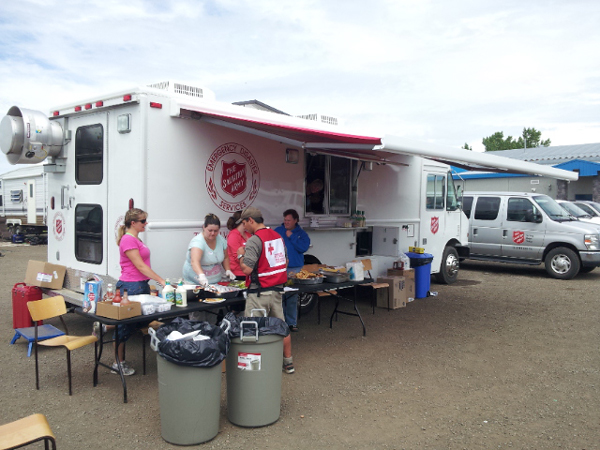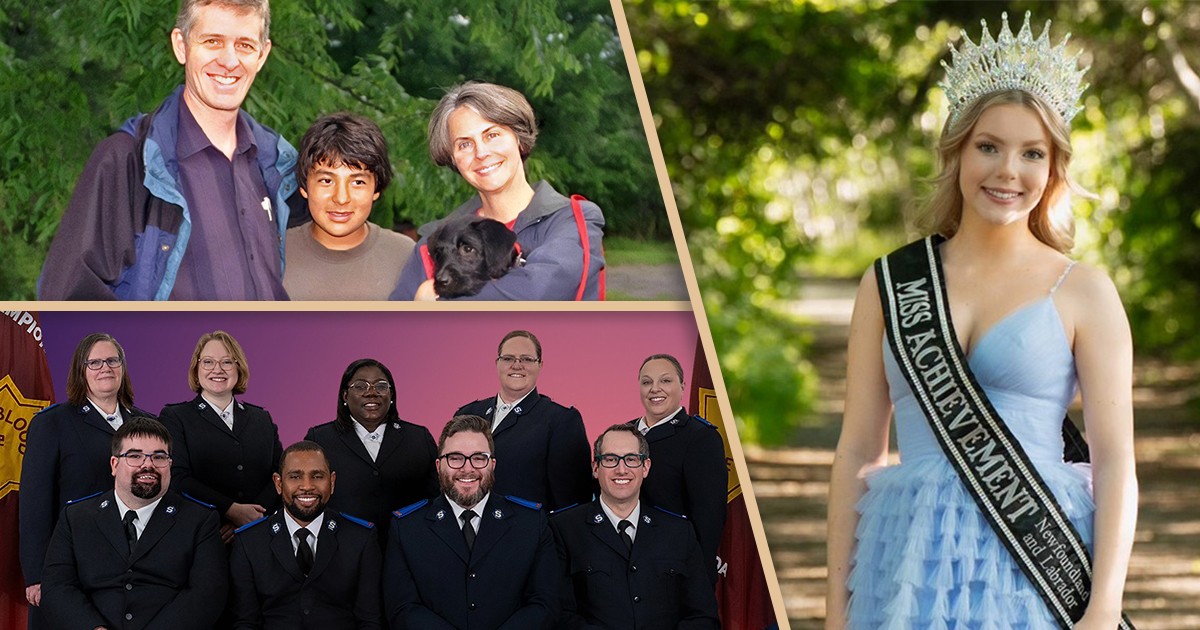 On Thursday, June 20, severe flooding hit the town of High River, Alta., forcing 13,000 people from their homes. As of June 27, residents are still on evacuation, and it will be several more days before they are able to return.
On Thursday, June 20, severe flooding hit the town of High River, Alta., forcing 13,000 people from their homes. As of June 27, residents are still on evacuation, and it will be several more days before they are able to return.
Lieutenants Cory and Kelly Fifield, corps officers at Foothills Church and Community Ministries in High River, have been on the scene from the beginning, providing assistance and support to the displaced. Associate editor Kristin Fryer spoke to Lieutenant Cory Fifield by telephone at the evacuation centre in Blackie, Alta., on June 25.
Can you walk me through what you have been doing since the flooding began last Thursday?
It started out as a typical morning. I was at the office, doing normal things, when my thrift store manager came in and told me there was water coming down the street. When I went out to look, I realized that it was not just a little water—it was raging water. We quickly got in our program truck and went to get some sandbags, but by the time we got back to our family services office and thrift store, there was water up to the doors, surrounding the building. So we evacuated the store, threw the sandbags down and started packing clothes and whatever we could find against the doors to try to limit the damage. Then we went to see what else we could do.
Around 11 a.m., we came across a member of our congregation who was trying to get to her house to sandbag it. Little did she know that her house was already under several feet of water, and her husband, who is almost 90 years old, was still inside. We followed her to the house and were able to find an old door which we used to carry her husband, along with a garbage bucket with a few of his belongings.
I then joined my wife, Kelly, at the evacuation centre at the high school. When I arrived, they were shifting gears because at least three-quarters of the town was under mandatory evacuation, so they were about to move the evacuation centre from the high school to the arena in Nanton, Alta., about 30 kilometres south of High River.
Despite the flooding, we managed to get to Nanton and were at the evacuation centre helping people get settled there. At this point, cell service was terrible. We had the emergency disaster services Community Response Unit (CRU) from Calgary coming to High River to help us, but we weren't able to contact them. They couldn't get through to Nanton because the roads were closed, so they were redirected to Blackie, about 30 kilometres east of High River.
 June 20, 11 a.m.: Flood waters surround The Salvation Army's thrift store and family services and church office in High River, Alta.
June 20, 11 a.m.: Flood waters surround The Salvation Army's thrift store and family services and church office in High River, Alta.
Above: June 25: Volunteers serve meals at the evacuation centre in Blackie, Alta.
Since that time, we've focused our attention primarily on Blackie, where The Salvation Army is providing meals through a CRU from Lethbridge, Alta. As well as the team of people from Lethbridge, we have teams from our own congregation who are helping us serve food to the 300 people who are residing here.
What else are you doing in Blackie?
We're assisting with pastoral care, chatting with people who have been evacuated, tracking down congregation members, making sure that they're all safe, making sure people have registered as evacuees. A lot of people got out OK, but never registered, so the police weren't sure who was missing and who wasn't.
What's the situation like at the evacuation centre today?
Things are starting to settle. The first couple of days were pretty scattered. No one was prepared for the flood to be of this scale. Once it became clear that we wouldn't be going home soon, we began to look for options in terms of refrigeration for food, garbage, linens. People only had the shirts on their backs, so we had to get clothes in.
Yesterday [June 24], the mayor of High River came in with skyview pictures of most of the town. After that, things really began to shift because people were able to visualize what's going on in town. Most people left thinking they would be away for a couple of days and then back home. And when the pictures went up, they realized that their homes were under 6-8 feet of water. People cried as they looked at pictures, trying to find their homes.
People are asking, “How do I rebuild? I've got nothing. I go home to nothing.” Those people have really been struggling the last few days, trying to grasp that. Some people are talking about finding new homes somewhere else. “I can't go back to High River because I can't go through this again.”
What kind of pastoral care have you been able to provide?
We've been coming alongside people, some of whom we know through our community ministries and our church ministry. Many of them are doing well. They're resilient—they know we're going to get through this. It's not just one or two people—this is an entire town. The people who have lost everything, they're not alone, and that makes a big difference for them.
As a church body, we are letting them know that we're going to walk through this with them—The Salvation Army is here for the long haul. As much as we have moments where we get emotional, I thank God that we're able to come here and help, that there's a Salvation Army in the community. This is our home, too. We're not coming in from the outside. When I go up to someone and say, “I'm the officer from High River,” that means something because they know that I left as well.
How has the flood affected you and your wife personally?
Yesterday we had our first meeting with some of the other Emergency Disaster Services (EDS) personnel who were in the area, and someone mentioned us being in full uniform, and we said, “This is all we have.” And Kelly is eight-months pregnant, so we're acknowledging the reality that we may not be in our home when our baby comes. But we know that the Lord is watching over us and we just need to take it one day at a time. The Salvation Army staff at divisional headquarters have been amazing, communicating with us regularly, making sure that we're OK and that we have what we need.
Were your quarters damaged?
We're not sure at this point. We do know that our church has suffered some level of water damage, and our food bank and thrift store were under 6-8 feet of water at some point.
What can other Salvationists do to help and support High River at this time?
They can pray. They can also donate to The Salvation Army's flood relief fund because we know that the financial loss is going to be significant. Even with government assistance, there will be people who have lost stuff and won't have money to replace it. That's another avenue where we as The Salvation Army can step in and help.
For updates on the flood situation in High River, visit The Salvation Army's Facebook page: www.facebook.com/salvationarmyfoothills
Those who are interested in volunteering can contact The Salvation Army at info_ab@can.salvationarmy.org or 403-410-1113.










thank God even through such devastation and as he goes through this crisis with his pregnant wife he didn't hesitate to jump right in and help-a true servant of the Lord indeed. and to read Lt. Cory quote "As a church body, we are letting them know that we’re going to walk through this with them—The Salvation Army is here for the long haul. As much as we have moments where we get emotional, I thank God that we’re able to come here and help, that there’s a Salvation Army in the community." this measure of comfort and love is truly of God. Thank you Lt. Cory for allowing God to use you in so many ways in this situation. May God Bless you and keep you and shine His face upon you... ``They can pray`` you say - of course fervently!!